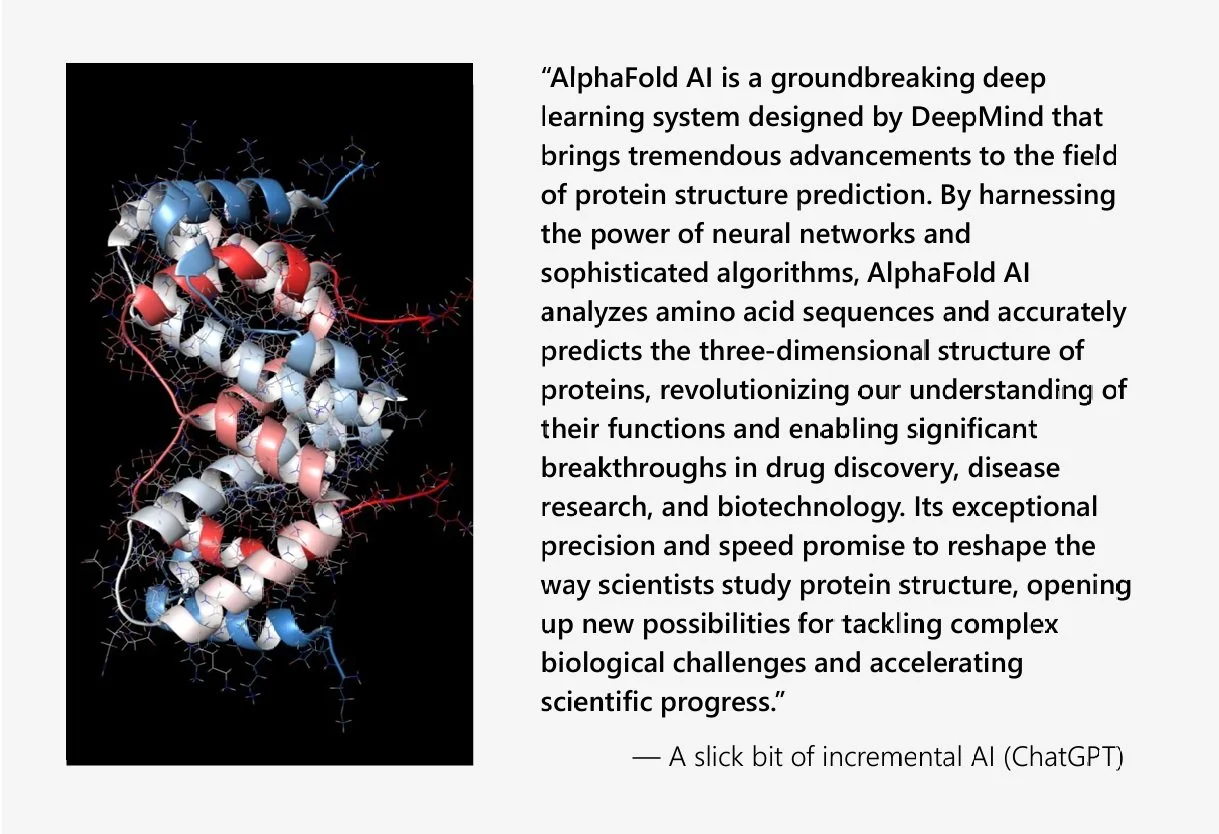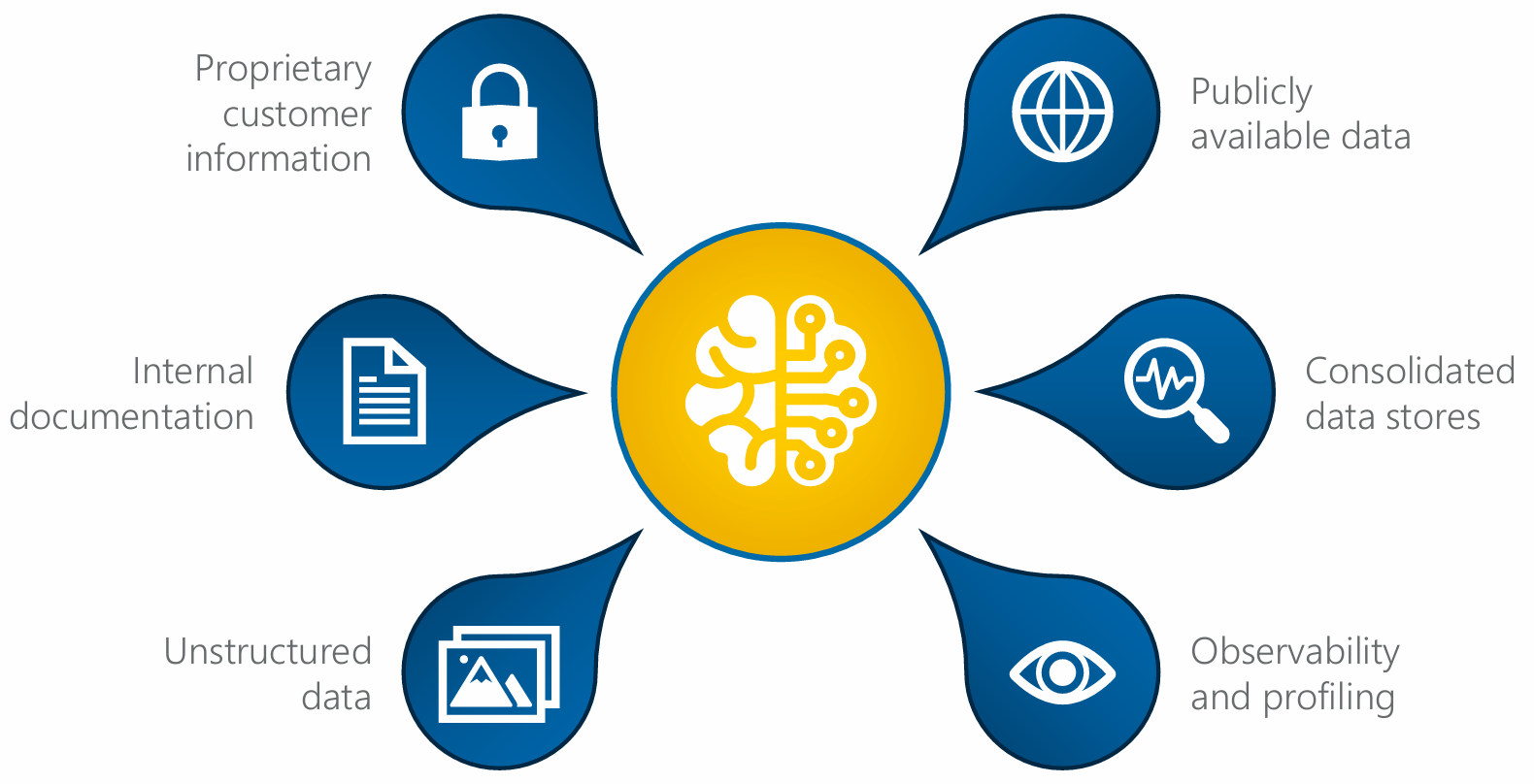
Trustrorthy AI
Knowledge Base
Differential AI
We’re finally on to what popular culture might consider the “fun” bit, or at least the bit that dominates the imagination when it comes to artificial intelligence’s supposedly boundless possibilities. Whereas Incremental AI includes the scenarios that improve upon solo human performance of activities that would have been performed anyway, Differential AI broadly encapsulates workloads that would not have likely been performed by humans alone, scenarios that are valuable to the organization because they allow you to jump out ahead of your competition, to offer your customers something that you’d not have otherwise been able to provide. We once toyed with the idea of calling this “Secret Sauce AI” or “Moonshot AI” to underscore the point.
Hallmarks of these differentiating, accelerative workloads are that they require a degree of creative thinking to dream up, can be challenging to implement, often involve deriving insights by mixing data that you already own but never had the ability to co-mingle, and operate along a time dimension, that is to say, involve some sort of computation or connection that must be completed within a window of time that makes human intervention more challenging.
On top of this, these workloads will require a degree of flexibility on your part, at least in the early days as you figure out exactly how to harness the power of this newfangled thing you’ve built.
AlphaFold , developed by Alphabet’s DeepMind lab to make predictions about protein structure, is one of the world’s more successful examples of this type of differential AI. We will not - nor are we qualified to - dig too deeply into the biological particulars of what the thing does, but we will draw on some incremental AI to summarize it for us below.
In theory, many humans might have spent many years working this out in the absence of artificial intelligence. But this would have been impractical, if even achievable, and in this way AlphaFold serves as a (ridiculously brilliant) example of differential AI offering a benefit to its creator far beyond what would have otherwise been possible.
That said, differential AI need not offer groundbreaking promise for the future of humanity to be useful to one organization, team, or even to an individual’s world of work.
Figure 24: The practical examples discussed here each, in their own way, assimilate and reason over a combination of proprietary customer information, internal documentation, unstructured data, publicly available data, consolidated data stores, and observable characteristics of the physical world to produce a response or outcome.
Let’s consider some practical examples below.
Professional Services
For example, a law firm, accountancy, or consultancy might use AI to produce regular guidance advising its clients of upcoming regulatory or legal changes that may impact their business in the various jurisdictions in which they operate. A typical firm would know who its clients are, in which countries and sub-national regions (e.g. states, provinces, territories, counties, autonomies, etc.) its clients operate, and possess data concerning its clients' products or services. This proprietary information could be used in conjunction with (a) publicly available information and (b) internal documentation - indexed by Azure AI Search, of course - concerning regulatory or legal changes taking effect over (say) the next 6-12 months to produce tailored guidance for individual clients.
Public Sector
A public sector law enforcement or foreign affairs organization might possess information in one quasi-consolidated data store that Firm A is owned by Firm B, which is itself a shell company owned by (say) a sanctioned Russian official. Another quasi-consolidated data store, or some selection of unstructured data may also indicate that Firm B owns a yacht that the global automatic identification system (AIS) knows is presently docked in an allied port. This serves as a great example of, among other things, workloads with a time dimension. A human could connect these dots, but it is less likely that a human could connect all these dots in a potentially narrow window of time during which that particular yacht was docked in that particular port.
Agriculture
An agricultural firm depends on phenotyping (observing and analyzing an organism's observable traits or characteristics to gain insights into its genetic, physiological, or environmental attributes) to breed and produce new vegetable varieties. This extremely laborious process can be significantly enhanced by image analysis assessing thousands of images per minute.
…and on it goes.
There are clearly overlaps between incremental, extensible, and differential AI workloads. Think of these as conceptual categories meant to help you place them in context of your AI strategy (rather than hard technical boundaries). The three examples above share, however, that they move their organization’s use of AI from that which betters or enhances something that would have been done anyway to the realm of achieving results that could not have (realistically) been otherwise produced.
As AI technology evolves, though, it seems certain that the line between these different flavors of AI workloads will blur further. We will move from “bolt-on” architectures and user experiences wherein AI is grafted onto pre-existing workloads or used in legacy form factors such as “the app” to “born-in-AI” solutions that have been architected from the ground up with AI in mind.
There is no perfect historical comparison here, but let’s illustrate the point by thinking back to the early days of smart watches. When this new form factor first became available, many of its early applications simply shrank that which was available in the mobile phone form factor onto a tiny, wearable screen. These apps were predictably terrible until developers began thinking of the wrist as an entirely new form factor with different constraints and opportunities.
AI represents a much more fundamental paradigm shift than a screen that’s similar to other screens but smaller; running apps that are similar to other apps but on your wrist. Suffice it to say, though, expect the discipline of born-in-AI workload design to mature in the years ahead until the industry at large accumulates enough experience to really understand what’s possible, what works, and – importantly - what doesn’t.
One can get a sense of where this may be going in the form of Project Sophia , which Microsoft describes as aiming “to help our customers solve complex, cross-domain business problems with AI, by enabling them to interact with data in new ways and answer strategic questions that drive better outcomes.” There’s no way to know if this is a form factor that will stick, but Sophia’s very existence points the way towards an era of creativity where even the future of the venerable “app” is up for grabs.
In any eventuality, it seems likely that those of us whose idea of what computing can be was shaped by our years growing up watching the crew of Star Trek verbally converse with “the computer” and be handed back responses that we’d now call “generative” will not have to wait long to see these dreams become reality.
What differential AI looks like in any specific organization is, well, specific to each organization. This of course risks spiraling into its own form of the use case death spiral wherein fixation on an endless stack of workloads prevents action on workloads one, two, and three. Differential AI also takes us into the realm of trying to solve today’s problems with tomorrow’s promises, reference one of our original, foundational principles:
“Any future-ready AI strategy must be flexible, meaning it is able to absorb tomorrow what we don’t fully grasp today.''
Your differential AI workloads ought to be baked into your AI strategy’s roadmap from the start, shepherded by technology and business leaders with a healthy tolerance for flexibility.


